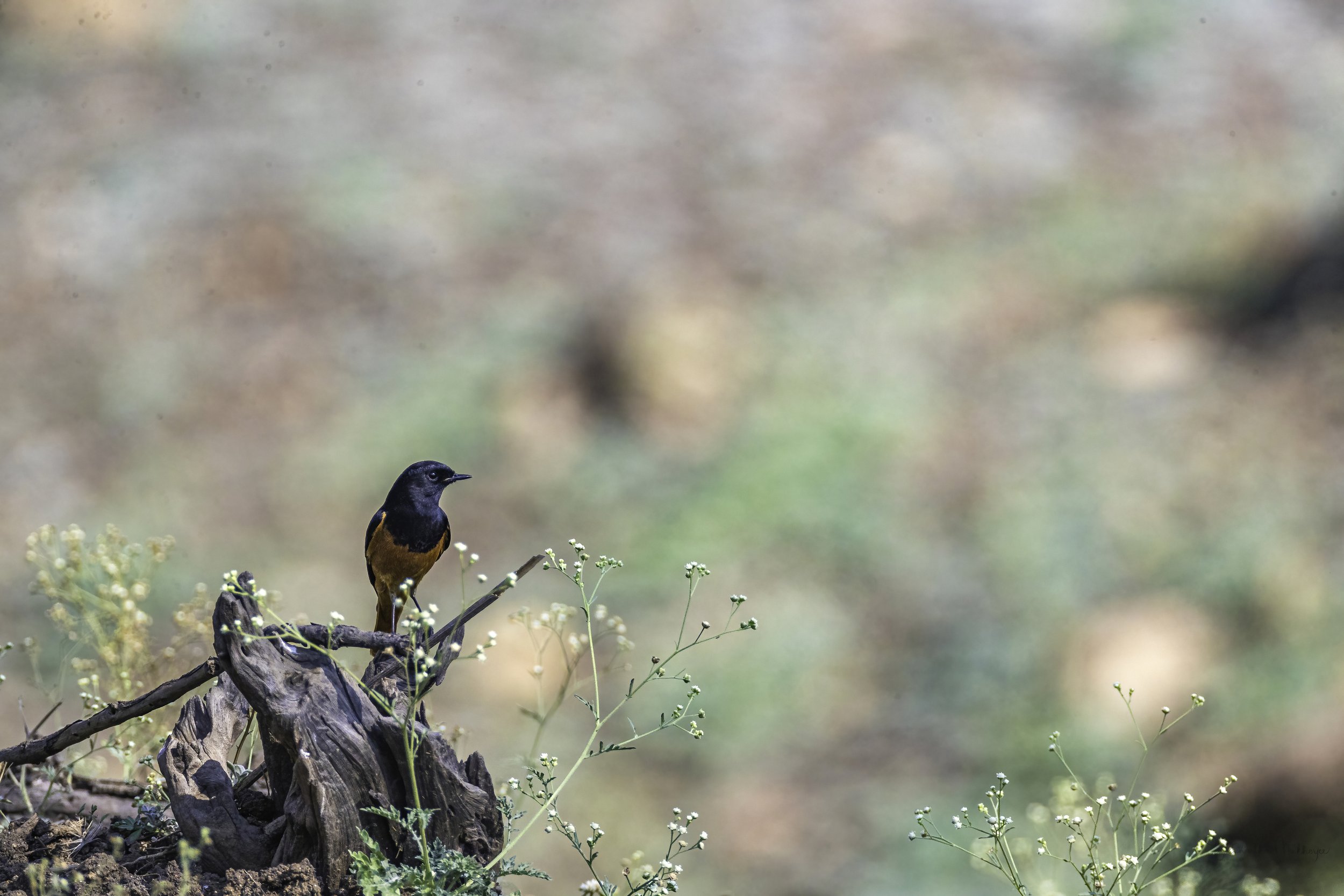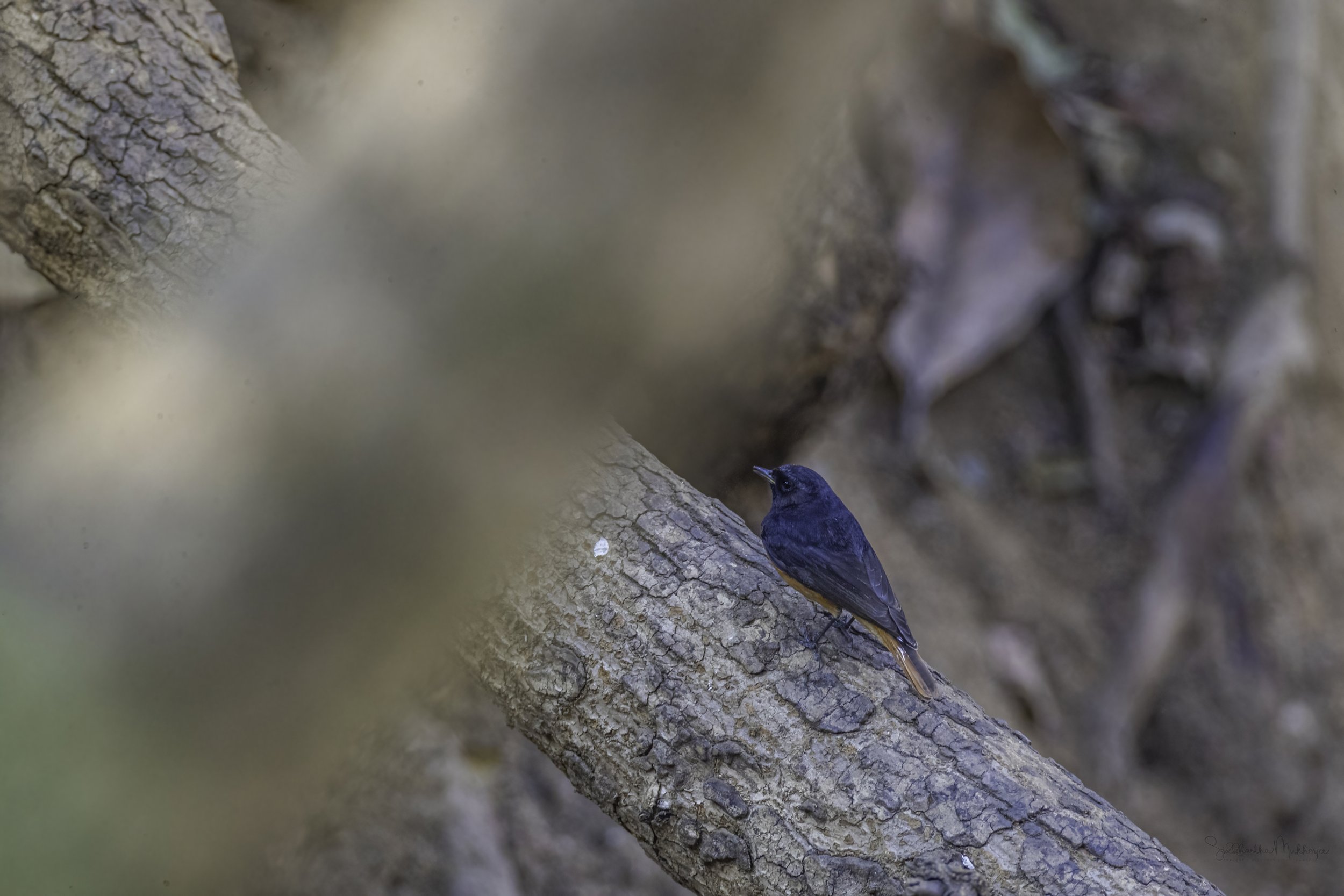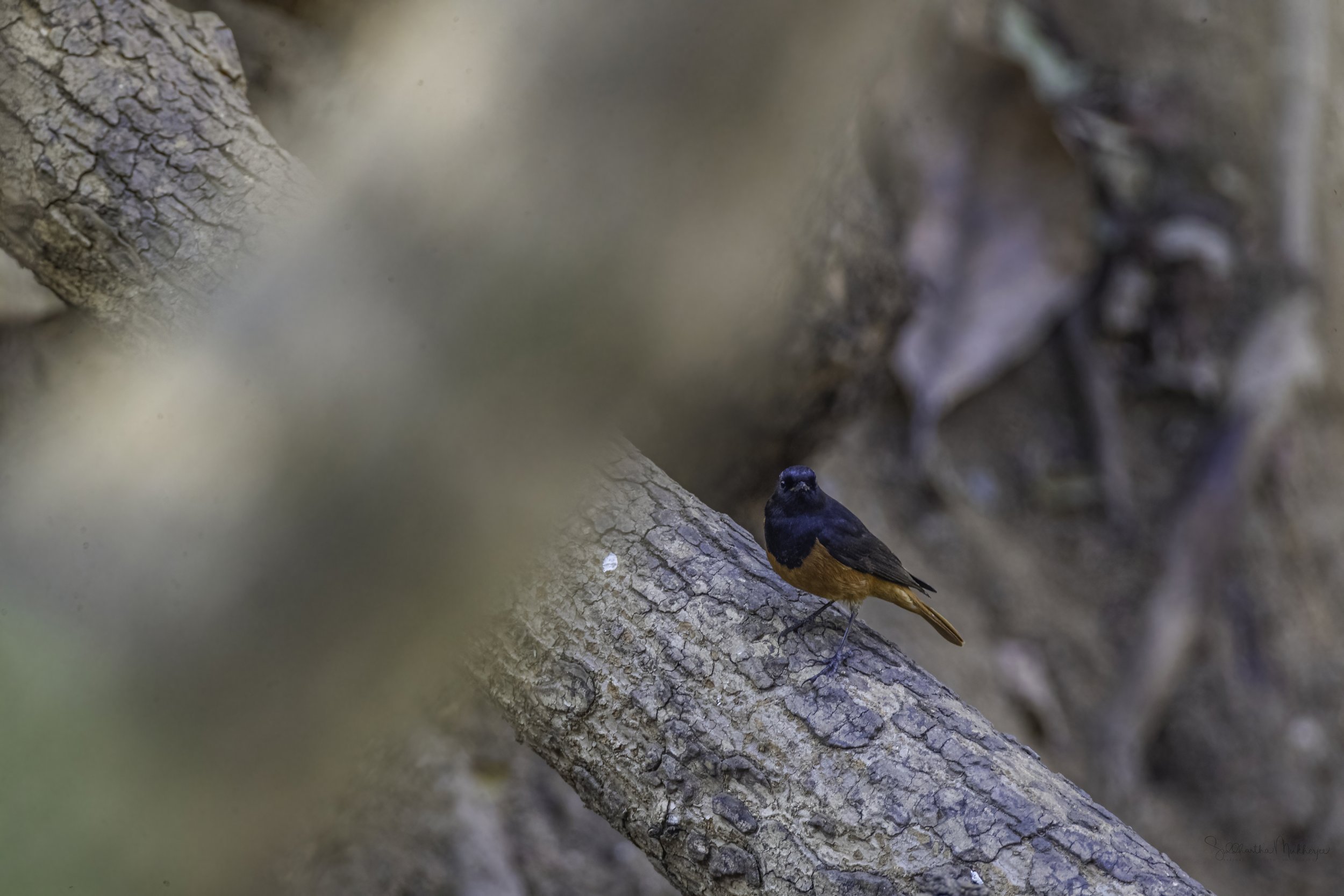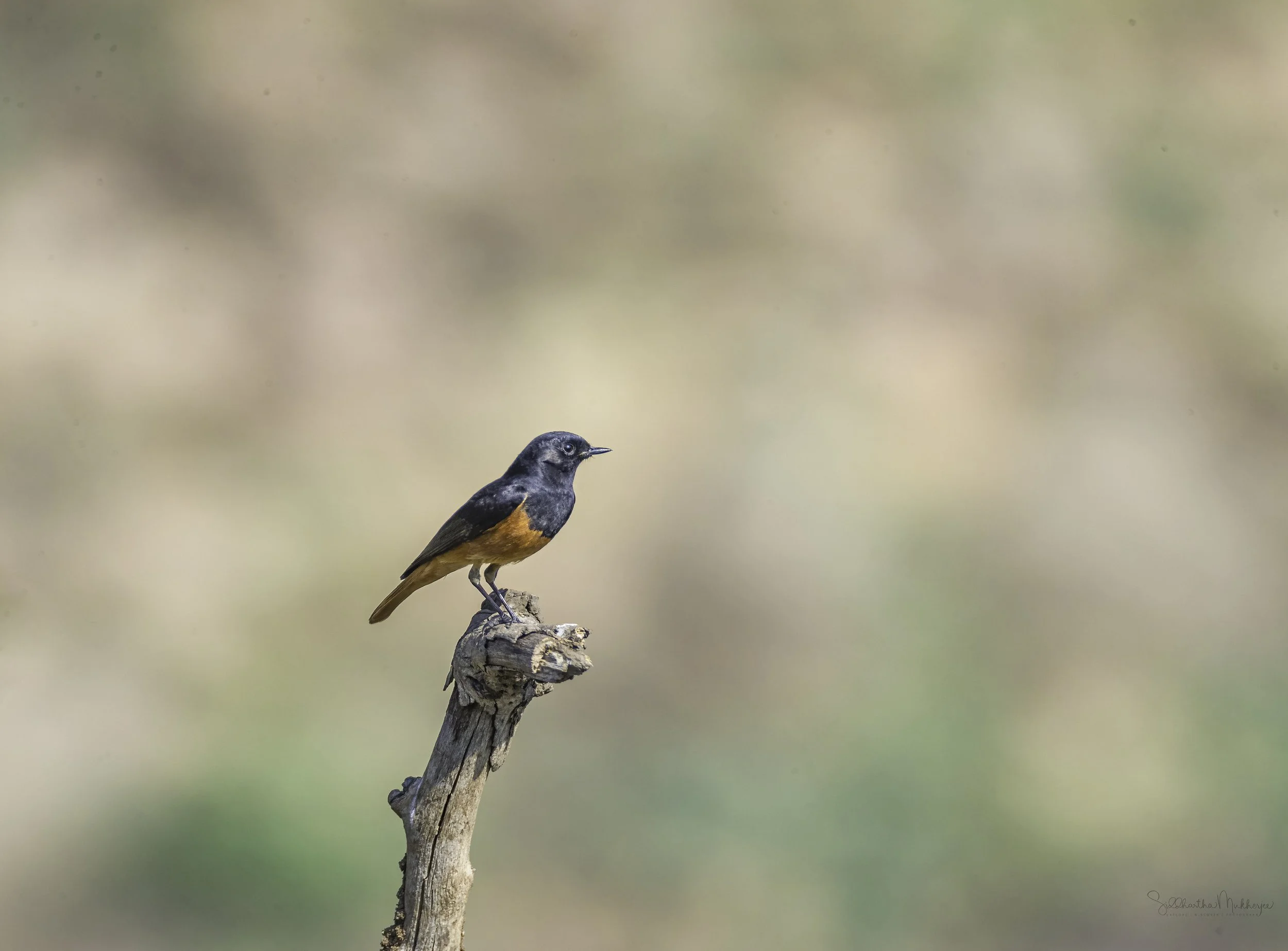Black Redstart
Phoenicurus ochruros
Narsapur Forest Range, Telangana
It’s easy to assume, with bird names, that we know what they mean, and often that assumption is quite correct. Woodpeckers peck wood, bee-eaters feed on bees, and whitethroats are indeed white around the neck. Other names seem almost wilfully obscure: what on Earth does the name puffin mean? Or hobby? Why are turtle doves named after reptiles? And don’t get me started on some of the more bizarre bird names found around the world – from zitting cisticola, leaflove to hardhead, and bananaquit to bearded mountaineer.
Yet, as I discovered when I was researching the origins of bird names, if you dig deep enough, you unearth all sorts of fascinating stories about what the names mean, where they came from and, especially, the men and women who created them. The origin of some names may, at first, seem obvious, yet are not quite as straightforward as they appear. Take the simplest of all bird names: blackbird. It’s a bird, and it’s black. Isn’t that all we need to know? But what about the crow, rook, raven? They’re black too so why was the Blackbird singled out as a ‘black‘ bird?
The reason for this apparent anomaly is that, until the late medieval period, birds were not called “birds” at all, but fowls – as in Chaucer’s poem The Parliament of Fowls. The word bird (originally the Anglo-Saxon brid), referred only to young fowls, or chicks. Then, sometime around the time Chaucer was writing, this meaning began to shift. From then on, although “fowl” was still used for larger birds such as members of the crow family, “bird” became the norm for all smaller birds, including the blackbird. So, at the time it was named, this really was the only truly “black bird”.
Many of our oldest bird names – including raven, rook and crow – are onomatopoeic: they imitate the sound made by the bird itself. Cuckoo, chiffchaff and kittiwake are other well-known examples. Far less obvious ones include nightjar (from the “churring” sound made by this nocturnal bird), bittern (from its deep, booming call), and the aforementioned turtle dove. “Turtle” is a corruption of the bird’s soft “tur-tur” call, so has nothing to do with the aquatic reptile.
Other ancient bird names relate to a bird’s appearance: its size, colour, shape or distinctive markings. Again, some are obvious: such as great spotted woodpecker, long-tailed tit and the Dollarbird. But with others it takes some linguistic detective work to uncover their true meaning. Take the familiar redstart and wheatear. Both names superficially make sense, yet as soon as you look more closely, they become problematic. After all, redstarts are not noticeably jumpy, and I’ve certainly never seen a wheatear in a field of wheat.
The reason these names appear puzzling is down to the Norman Conquest of Britain. Perhaps the greatest change that resulted from this invasion was in everyday language: within a century or so, Anglo-Saxon had merged with Norman French to create a new, hybrid tongue known as Middle English – the precursor to the way we speak today. But as the old language fell into disuse, some of its words no longer made any sense. So, by a process called false etymology, people made up new versions, which sounded plausible, even if their original meaning had been lost. Thus, the Anglo-Saxon “red steort” (meaning red tail) turned into redstart; and “wheteres” – literally white arse, changed into wheatear. Norman French also had a major influence on the names of ducks (mallard and wigeon), game birds (pheasant and partridge), and raptors (peregrine and hobby).
What these all have in common is that they were important to the Norman nobility – either as food, or for hunting and sport – so their French names took precedence over the older, English ones. From the 18th century onwards, existing names were codified by professional ornithologists who also coined new ones, such as black-tailed godwit or white-fronted goose. A trend also arose for naming birds after people: sometimes those who had discovered the species, such as George Montagu (Montagu’s harrier).
I have here some redstarts photographed at different locations over the last few years like the White-capped Redstart, White-bellied Redstart to name a couple. Click on the links below to read about the rest of them.
But this time it is about a bird one needs to catch before March ends - the Black Redstart.
Narsapur Forest Range
Being located in the Deccan Plateau in the central stretch, the prosperous state of Telangana has sub-tropical climate and the terrain consists mostly of hills, mountain ranges, and thick dense forests covering an area of 27,292 km². The annual rainfall ranges between 1,100 mm to 1,200 mm and the annual temperature varies from 15 C to 45 C. The state is drained by a number of rivers which include the Godavari and the Krishna.
Telangana is endowed with rich diversity of flora and fauna. It has dense teak forests on the northern part along the banks of river Godavari. As per the Champion & Seth Classification of Forest Types (1968), the forests in Telangana belong to three Forest Type Groups, which are further divided into 12 Forest Types. The State Government has taken up a massive greening programme, 'Telangana Ku Harita Haram' in the State to plant and protect 230 crore seedlings over a period of 4 years. This initiative aims at achieving the twin objectives of increasing the forest cover and reduce pressure on the existing forest resources, through massive community participation by Vana Samrakshna Samithis (VSS) and Eco-Development Committees (EDCs) in Protected Areas and Watershed Development Committees in the Watershed areas. Recorded Forest Area (RFA) in the State is 26,904 km² of which 20,353 km² is Reserved Forest, 5,939 km² is Protected Forest and 612 km² is Unclassed Forests. In Telangana, during the period 1st January 2015 to 5th February 2019, a total of 9,420 hectares of forest land was diverted for non-forestry purposes under the Forest Conservation Act, 1980 (MoEF & CC, 2019). As per the information received from the State during that last two years, 12,730 ha of plantations including avenue plantations in the State.
Three National Parks and nine Wildlife Sanctuaries constitute the Protected Area network of the State covering 5.08% of its geographical area.
The Narsapur forest range is spread over 30 km² at a easily drivable distance of 45 km from Hyderabad, the state capital. It is brimming with a plethora of exquisite and fragrant flora and fauna, natural rock formations and ponds. Located in the Medak district, the Narsapur forest is at its best during the monsoons. There are small steep elevations which are easy to climb and invariably most of these begin at a temple in the forest. There is also the Narsapur Forest Urban Park with a watchtower in close proximity which provides stunning views of the whole forest. Our sojourn starts at one of these temples just off the highway where we park our cars and trek into the forest. The area surrounding and in close proximity of the temple is teeming with bird life and if one has the patience one is assured of spotting numerous species as they forage in the foliage. One such and our focus this time was the Black Redstart.
Black Redstart
The Black Redstart (Phoenicurus ochruros) is a small passerine bird in the genus Phoenicurus. Like its relatives, it was formerly classed as a member of the thrush family (Turdidae), but is now known to be an Old World flycatcher (Muscicapidae). Other common names are Tithy's redstart, blackstart and black redtail. It is 13–14.5 cm in length and 12–20 grams in weight, similar to the common redstart.
The adult male is overall dark grey to black on the upperparts and with a black breast; the lower rump and tail are orange-red, with the two central tail feathers dark red-brown. The belly and undertail are either blackish-grey or orange-red (seen in the eastern subspecies); the wings are blackish-grey with pale fringes on the secondaries forming a whitish panel (western subspecies) or all blackish (eastern subspecies). The female is grey (western subspecies) to grey-brown (eastern subspecies) overall except for the orange-red lower rump and tail, greyer than the common redstart; at any age the grey axillaries and underwing coverts are also distinctive (in the common redstart these are buff to orange-red). One-year-old males are similar to females but blacker; the whitish wing panel of the western subspecies does not develop until the second year.
The first formal description of the black redstart was by the German naturalist Samuel Gottlieb Gmelin in 1774 under the binomial name Mottacilla ochruros. The genus Phoenicurus was introduced by the English naturalist Thomas Forster in 1817. Both parts of the scientific name are from Ancient Greek and refer to the colour of the tail. The genus name Phoenicurus is from phoinix, "red", and -ouros -"tailed", and the specific ochruros is from okhros, "pale yellow" and -ouros.
The black redstart is a member of a temperate Eurasian clade which also includes the Daurian redstart, Hodgson's redstart, the white-winged redstart, and maybe Przevalski's redstart. The present species' ancestors diverged from about 3 million years ago (mya) (Late Pliocene) onwards and spread throughout much of Palearctic from 1.5 mya onward. It is not very closely related to the common redstart. As these are separated by different behaviour and ecological requirements and have not evolved fertilisation barriers, the two European species can nonetheless produce apparently fertile and viable hybrids.
Black Redstart - Migration Map (Source: Birdcount.in)
This animated migration map was created from observations uploaded to the citizen science platform eBird up until 2020. Where present, the inset graph depicts the seasonal likelihood of finding this species (i.e. the proportion of eBird checklists) within its range in India alone. We are grateful to the many birdwatchers around the world who have enabled the creation of this animation by sharing their observations on eBird.
There are a number of subspecies which differ mainly in underpart colours of the adult males; different authorities accept between five and seven subspecies. They can be separated into three major groups, according to morphology, biogeography, and mtDNA cytochrome b sequence data.
P. o. phoenicuroides group - Basal central and eastern Asian forms which diverged from the ancestral stock as the species slowly spread west (c. 3–1.5 mya). Females and juveniles light grey brown.
Phoenicurus ochruros phoenicuroides. Tian Shan eastwards to Mongolia. Small; adult males have lower breast, belly and flanks deep rufous, pale wing-patch absent, sometimes white forehead. Overall quite similar to a much darker common redstart with black chest. Females and juveniles are similar to common redstart but have an overall sandier, paler colour and often a distinct buff eye-ring.
Phoenicurus ochruros murinus. Altai, Tuva, northern China and western Mongolia. Distinguished from the previous Turkestan subspecies by the absence of any contrast in the colour of the head, nape and back, all of which are concolorous dark grey.
Phoenicurus ochruros rufiventris. Turkmenistan eastwards through Pamir and Alay Mountains to Himalaya. Usually large; adult males like P. o. phoenicuroides, but darker overall, with black back and rufous-chestnut underside. Females with rufous tinge to underside. Exact limits with P. o. phoenicuroides unresolved.
Phoenicurus ochruros xerophilus. China east of and between ranges of preceding two. Large; colour pattern like P. o. phoenicuroides but paler. Included in P. o. rufiventris by many authorities.
Source: Birdcount.in
P. o. ochruros group - Western Asian forms, whose lineage separated from the gibraltariensis group c. 1.5–0.5 mya. Females and juveniles intermediate.
Phoenicurus ochruros ochruros. Eastern Turkey, Alborz, and Caucasus. Small, somewhat intermediate between P. o. phoenicuroides and P. o. gibraltariensis. Generally like latter, but rufous underside, pale wing patch weakly developed.
Phoenicurus ochruros semirufus. Levant. Small; adult males somewhat similar to rufiventris except in size. Black areas extensive.
P. o. gibraltariensis group - European population, which formed as a distinct subspecies probably during the last ice age. Females and juveniles dark grey.
Phoenicurus ochruros gibraltariensis. Western Europe east to the Crimea and western Turkey. Neck, upper back and shoulders dark slate grey to black in adult males, lighter than face and neck, pale wing patch strongly developed.
Phoenicurus ochruros aterrimus. Iberia and Morocco. Neck, upper back and shoulders black in adult males. Wide intergradation with P. o. gibraltariensis and treated as a synonym of it by many authorities.
We spotted this beautiful bird perched fairly close and flitting from branch to branch. We scrambled our telephotos and proceeded to click away. Find the gear in my bag. It was a lovely experience to have the bird perch so close obviously as curious about us as much as we were about him.
With that said it is time to move onto the gallery of this beautiful redstart. I have also had the good fortune to record and photograph some of the other redstarts like the White-capped Redstart, the White-bellied Redstart, the Plumbeous Water Redstart & the Blue-fronted Redstart. Read about them here and here.
‡‡‡‡‡
At first we waited where earlier visits had spotted the bird - a beautiful perch - a stump low to the ground on the slight bank of a dry stream bed. While we waited there, some of the group went in search of the bird in the denser brush where it was said to have a nest. During this time the bird flitted in and out numerous times and this initial sequence is shot as it flew in, around and out of this fallen acacia at a little distance from us not once coming to the perch we waited at. At this time the bird seemed agitated and shy and this was most likely because of all the moving around we were doing. With all this moving around and the bird flitting very quickly in and out it was very difficult to spot and photograph the bird.
The redstart perched in the general neighbourhood of this fallen This second sequence was shot well within the brush from the rocky banks of a small pond. This is the general area where the bird is said to have nested but during our time here not once did I see the female. We had to move into this location from our earlier one because one “specialised birder and local expert“ walked right through the river bed the bird was frequenting disturbing its pattern of flight and the already agitated bird flew back into the brush.
This next sequence was after quite a while, when the sun was well up and the bird was out and about foraging. It gave us a beautiful setting perching sometimes on a tree, sometimes on a stump and sometimes on the ground before finally flying off in to the denser brush.
Related Posts




























